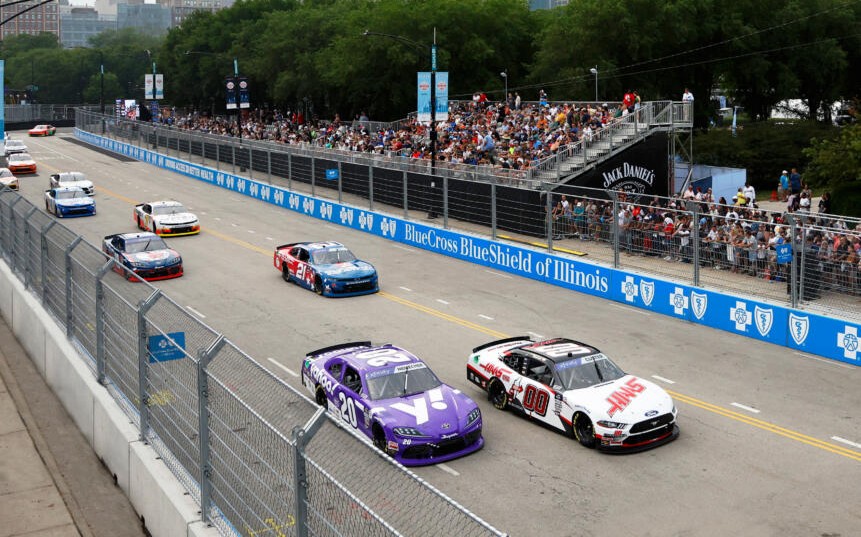NASCAR Navigates Uncertainty as Chicago Street Race Gears Up for Crucial Third Year
As NASCAR prepares to return to the heart of downtown Chicago for the third consecutive year, the future of the highly anticipated street race remains uncertain. While excitement builds for the upcoming event over the first weekend of July, key questions loom about whether the city and NASCAR will continue their partnership beyond the current contract.
Julie Giese, track president and one of the primary architects behind NASCAR’s urban vision, is overseeing the fast-paced and intricate construction of the 2.2-mile, 12-turn street course. Her focus, however, is locked on ensuring the 2025 Chicago Street Race is a success before any long-term decisions are made. With a three-year agreement between NASCAR and the city of Chicago signed in 2022—including two mutual option years—Giese confirmed that while the discussions are ongoing, the current emphasis is on flawless execution.
“We’re committed to delivering a great 2025,” Giese said, noting that although the future is being discussed, planning and logistics for this year are taking priority.
Jason Lee, senior adviser to Mayor Brandon Johnson, echoed a similar sentiment, acknowledging that both parties are having parallel conversations about the long-term potential of the event. Lee highlighted improvements NASCAR has made in community engagement and event management, which are contributing to a more productive relationship between the organization and city officials. The original agreement was brokered under former mayor Lori Lightfoot, and Johnson’s administration is now tasked with evaluating the race’s ongoing viability.
Among the key factors being considered is the timing of the race. Lee noted that the current early July date puts strain on law enforcement and emergency services, which are already stretched thin due to holiday events. Shifting the event to a different weekend is one possibility that has been previously discussed and could be revisited, though it would require balancing both Chicago’s packed summer calendar and NASCAR’s national schedule.
Adding to the intrigue is a recent report indicating that NASCAR is close to finalizing a deal for a street race in the San Diego area, potentially as early as 2026. While Giese declined to confirm discussions related to Southern California, she made it clear that multiple street courses could coexist on the NASCAR calendar. She emphasized that the Chicago race was always intended as a proof of concept, and its initial success demonstrated the potential of urban racing.
The Chicago event stands apart from traditional speedway races, offering not only high-octane action but also a festival atmosphere designed to attract both new fans and longtime supporters. With its route winding past Lake Michigan and through Grant Park, the race brings together NASCAR’s Xfinity and Cup Series alongside live music, food vendors, and family activities. The move away from Chicagoland Speedway in Joliet—NASCAR’s former Chicago-area venue that hosted races until 2019—signaled a shift in strategy toward reaching urban audiences.
Ben Kennedy, NASCAR’s senior vice president of racing development and strategy, has previously called Chicago one of NASCAR’s top three global fan markets, highlighting the city’s significance in the organization’s broader vision.
Although the inaugural race faced skepticism from some local businesses and residents due to street closures and disruption in a key tourist zone, improvements have been made. The construction schedule, once spanning 43 days in 2023, has been streamlined to just 25 days this year. Viewing areas have been reconfigured based on fan feedback, and the concert stage has been relocated to the start-finish line for a more immersive experience. Notably, children 12 and under receive free admission on both Saturday and Sunday, a move aimed at encouraging more family participation.
Despite persistent challenges from inclement weather—rain heavily impacted both the 2023 and 2024 races, even forcing schedule adjustments—drivers and fans have found plenty to love about the Chicago course. Memorable moments have included Shane van Gisbergen’s historic victory in 2023 and Alex Bowman’s long-awaited return to the winner’s circle in 2024. The course has also earned praise for being “racy” with good passing zones and stunning urban scenery.
Veteran driver Denny Hamlin summed up the sentiment across the paddock: “The track has been good. It’s racy, it has passing zones, and the backdrop is fantastic. There are a lot of positives here.” He added that while the event may evolve or rotate in the future, Chicago has laid the foundation for what successful street racing in NASCAR could look like.
As the 2025 race draws closer, both the city and NASCAR will be closely watching not only the logistics but also the public and commercial response. With high stakes and even higher expectations, the Chicago Street Race stands as both a celebration and a test of NASCAR’s expanding identity. Whether it becomes a permanent fixture or a bold experiment remains to be seen, but one thing is certain—the Windy City knows how to put on a show.
